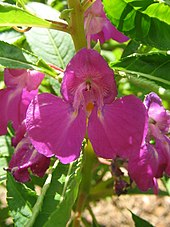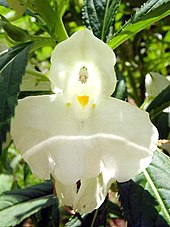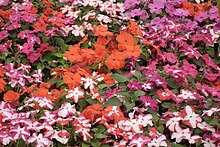Impatiens is a genus of about 850–1,000 species of flowering plants, widely distributed throughout the Northern Hemisphere and tropics. Together with the puzzling Hydrocera triflora, this genus makes up the family Balsaminaceae. Such a situation is highly unusual, and phylogenetic studies might reveal that Impatiens needs to be split up; some of its species might be closer to Hydrocera than to their presumed congeners.
 Common names include impatiens, jewelweeds, and, somewhat ambiguously, "balsams" and "touch-me-nots". As a rule-of-thumb, "jewelweed" is used exclusively for Nearctic species, "balsam" is usually applied to tropical species, and "touch-me-not" is typically used in Europe and North America. Some species commonly planted in horticulture have altogether more fanciful names, such as "Busy Lizzie" (the well-known I. walleriana).
Common names include impatiens, jewelweeds, and, somewhat ambiguously, "balsams" and "touch-me-nots". As a rule-of-thumb, "jewelweed" is used exclusively for Nearctic species, "balsam" is usually applied to tropical species, and "touch-me-not" is typically used in Europe and North America. Some species commonly planted in horticulture have altogether more fanciful names, such as "Busy Lizzie" (the well-known I. walleriana).Description
 Some species are annual plants and produce flowers from early summer until the first frost, while perennial species, found in milder climates, can flower all year. Regardless of their lifespan, the largest impatiens grow up to about 2 meters (c. 7 ft) tall, but most are less than half as tall. The leaves are entire and shiny; their upperside has a thick, water-repellent cuticula that gives them a greasy feel. Particularly on the underside of the leaves, tiny air bubbles are trapped under the leaf surface, giving them a silvery sheen that becomes pronounced when held under water. The name "jewelweed" possibly refers to these shiny leaves, particularly obvious after rains when water drops reflect the sunlight like a prism. However it is more likely that the name is derived from the robin egg blue of the surface of the seed beneath the dark brown aril, or seed coat.
Some species are annual plants and produce flowers from early summer until the first frost, while perennial species, found in milder climates, can flower all year. Regardless of their lifespan, the largest impatiens grow up to about 2 meters (c. 7 ft) tall, but most are less than half as tall. The leaves are entire and shiny; their upperside has a thick, water-repellent cuticula that gives them a greasy feel. Particularly on the underside of the leaves, tiny air bubbles are trapped under the leaf surface, giving them a silvery sheen that becomes pronounced when held under water. The name "jewelweed" possibly refers to these shiny leaves, particularly obvious after rains when water drops reflect the sunlight like a prism. However it is more likely that the name is derived from the robin egg blue of the surface of the seed beneath the dark brown aril, or seed coat. The flowers, up to 2–3 cm, around 1 inch long, in most species are made up by a shoe- or horn-shaped spur for the most part, with at least the upper petals insignificant by comparison; some have a prominent labellum though, allowing pollinators to land. Others, like the Busy Lizzie (I. walleriana), have flattened flowers with large petals and just a tiny spur that appear somewhat similar to violets (Viola), though these are unrelated eudicots. A few Impatiens species have flowers quite intermediate between those two basic types.
The flowers, up to 2–3 cm, around 1 inch long, in most species are made up by a shoe- or horn-shaped spur for the most part, with at least the upper petals insignificant by comparison; some have a prominent labellum though, allowing pollinators to land. Others, like the Busy Lizzie (I. walleriana), have flattened flowers with large petals and just a tiny spur that appear somewhat similar to violets (Viola), though these are unrelated eudicots. A few Impatiens species have flowers quite intermediate between those two basic types.These plants derive their scientific name Impatiens (Latin for "impatient") and the common name "touch-me-not" in reference to their seed capsules. When the capsules mature, they "explode" when touched, sending seeds several meters away. This mechanism is also known as "explosive dehiscence".
Ecology and uses
Balsams grow both in and out of direct sunlight; they prefer moist, rich soils, like roadside ditches, reed beds, fens, river banks and forest edges, and many are well able to colonize disturbed ruderal locations.
Impatiens foliage is used as food plants by the larvae of some Lepidoptera species (e.g. Dot Moth, Melanchra persicariae), as well as other insects, such as the Japanese Beetle (Popillia japonica). The leaves are toxic to many other animals, including the Budgerigar (Melopsittacus undulatus), but this popular pet will eat balsam flowers eagerly and as it seems it is not harmed by them. The flowers are visited by bumblebees and certain Lepidoptera, such as the Common Spotted Flat (Celaenorrhinus leucocera).
 In the 19th and 20th centuries, humans transported the Orange Jewelweed (I. capensis) to England, France, the Netherlands, Poland, Sweden, Finland, and potentially other areas of Northern and Central Europe. For example, it was not recorded from Germany as recently as 1996, but since then a population seems to have established itself in Hagen at the Ennepe river. These naturalized populations persist despite the plant not being grown in gardens on a regular basis. The Orange Jewelweed is quite similar to the Touch-me-not Balsam (I. noli-tangere) – the only Impatiens species native to Central and Northern Europe – and utilizes similar habitats, but no evidence exists of natural hybrids. Small Balsam (I. parviflora), originally native to southern Central Asia, is even more extensively naturalized in Europe.
In the 19th and 20th centuries, humans transported the Orange Jewelweed (I. capensis) to England, France, the Netherlands, Poland, Sweden, Finland, and potentially other areas of Northern and Central Europe. For example, it was not recorded from Germany as recently as 1996, but since then a population seems to have established itself in Hagen at the Ennepe river. These naturalized populations persist despite the plant not being grown in gardens on a regular basis. The Orange Jewelweed is quite similar to the Touch-me-not Balsam (I. noli-tangere) – the only Impatiens species native to Central and Northern Europe – and utilizes similar habitats, but no evidence exists of natural hybrids. Small Balsam (I. parviflora), originally native to southern Central Asia, is even more extensively naturalized in Europe. More problematic is the Himalayan Balsam (I. glandulifera), a high-growing species which displaces smaller plants by denying them sunlight. It is an invasive weed in many places, and tends to dominate riparian vegetation along polluted rivers and nitrogen-rich spots. Thus, it exacerbates ecosystem degradation by forming stands where few other plants can grow, and by rendering riverbanks more prone to erosion as it has only a shallow root system.
More problematic is the Himalayan Balsam (I. glandulifera), a high-growing species which displaces smaller plants by denying them sunlight. It is an invasive weed in many places, and tends to dominate riparian vegetation along polluted rivers and nitrogen-rich spots. Thus, it exacerbates ecosystem degradation by forming stands where few other plants can grow, and by rendering riverbanks more prone to erosion as it has only a shallow root system.The starkly differing flower shapes found in this genus, combined with the easy cultivation of many species, have served to make some balsam species model organisms in plant evolutionary developmental biology. Also, Impatiens is rather closely related to the carnivorous plant families Roridulaceae and Sarraceniaceae. Peculiar stalked glands found on balsam sepals secrete mucus and might be related to the structures from which the prey-catching and -digesting glands of these carnivorous plants evolved. Balsams are not known to be proto-carnivorous plants however.
Impatiens have become one of the most popular garden annuals. Hybrids, typically derived from "Busy Lizzie" (the well-known I. walleriana) and New Guinea Impatiens (I. hawkeri), have commercial importance as garden plants with a yearly business volume of about US $230 million. I. walleriana was originally collected from Costa Rica (where it grows as a weed), and bred through selection by Claude Hope. The original series of impatiens bred by Hope was the 'Elfin' series of cultivars, which was subsequently improved as the 'Super Elfin' series. Double-flowered cultivars also exist. But in tropical islands, such as Hawaii, Busy Lizzie can also become a noxious weed.
 Other Impatiens species, such as I. auricoma, Garden Balsam (I. balsamina), Blue Diamond Impatiens (I. namchabarwensis), Parrot Flower (I. psittacina),Congo Cockatoo (I. niamniamensis), Ceylon Balsam (I. repens) or Poor Man's Rhododendron (I. sodenii) are also often seen as ornamental plants. Note that insecticidal soap, commonly used against insect pests as it is less harmful to the environment and to most beneficial insects than halocarbon insecticides, is very toxic to some balsams. When controlling insect pests on Impatiens, insecticidal soap should be avoided.
Other Impatiens species, such as I. auricoma, Garden Balsam (I. balsamina), Blue Diamond Impatiens (I. namchabarwensis), Parrot Flower (I. psittacina),Congo Cockatoo (I. niamniamensis), Ceylon Balsam (I. repens) or Poor Man's Rhododendron (I. sodenii) are also often seen as ornamental plants. Note that insecticidal soap, commonly used against insect pests as it is less harmful to the environment and to most beneficial insects than halocarbon insecticides, is very toxic to some balsams. When controlling insect pests on Impatiens, insecticidal soap should be avoided.Source, Images: http://en.wikipedia.org/wiki/Impatiens















0 comments:
Post a Comment